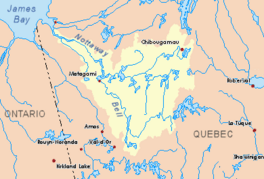Cherrier Lake facts for kids
Quick facts for kids Cherrier Lake |
|
|---|---|

Watershed of Nottaway River
|
|
| Location | Senneterre |
| Coordinates | 48°42′58″N 75°47′03″W / 48.71611°N 75.78417°W |
| Type | Damed lake |
| Primary inflows | "Mesplet Pass" which is the outlet of Mesplet Lake |
| Primary outflows | Saint-Cyr River South. |
| Basin countries | Canada |
| Max. length | 10.3 kilometres (6.4 mi) |
| Max. width | 2.4 kilometres (1.5 mi) |
| Surface elevation | 393 metres (1,289 ft) |
Cherrier Lake is a freshwater lake in the north-eastern part of Senneterre, Quebec, Canada. It is located in the Vallée-de-l'Or Regional County Municipality (RCM), which is part of the Abitibi-Témiscamingue region.
The area around Cherrier Lake is mainly used for forestry. This means people harvest trees there. Recreational tourism is also important. Many visitors come to enjoy outdoor activities.
You can reach the lake by a forest road that runs north-south. Another forest road goes east-west, serving the north side of the Lac Saint-Cyr Biodiversity Reserve.
The lake's surface is usually frozen from early November until mid-May. It is generally safe to walk or play on the ice from mid-November to mid-April.
About Cherrier Lake
Cherrier Lake is about 10.3 kilometres (6.4 mi) long. At its widest point, in the northern part, it measures 2.4 kilometres (1.5 mi). The lake is located at an elevation of 393 metres (1,289 ft) above sea level.
The lake gets its water from the "Mesplet Pass" in the north. This pass is the outlet of Mesplet Lake. Water also flows into Cherrier Lake from two smaller, unnamed lakes in the south.
Lake's Unique Shape
Cherrier Lake has a very interesting shape. It looks like a large, upside-down "U". Each side of this "U" forms a separate outlet on the east side of the lake.
One outlet from Cherrier Lake connects to the Saint-Cyr River South. The other outlet joins the same river about 7.5 kilometres (4.7 mi) downstream. These two outlets create an island that is about 8.9 kilometres (5.5 mi) long and 3.6 kilometres (2.2 mi) wide. This island runs alongside the Saint-Cyr River South.
Nearby Waterways
The southern outlet of Cherrier Lake is located on the lake's east shore. From this point, you can find other important waterways:
- About 5.1 kilometres (3.2 mi) north of where the Saint-Cyr River South meets the Mégiscane River.
- About 16.7 kilometres (10.4 mi) north-east of the mouth of Mégiscane Lake. The Mégiscane River flows through this lake.
- About 103.4 kilometres (64.2 mi) north-east of where the Mégiscane River flows into Parent Lake (Abitibi).
- About 372 kilometres (231 mi) south-east of the mouth of the Nottaway River, which flows into Rupert Bay.
- About 61.0 kilometres (37.9 mi) south-west of the village of Obedjiwan.
- About 101.7 kilometres (63.2 mi) east of the village of Lebel-sur-Quevillon.
Why is it Called Cherrier Lake?
The name "Lac Cherrier" (Cherrier Lake) comes from the name of the area, called the Cherrier township.
The name honors Como-Séraphin Cherrier (1798-1885). He was a very important person in Quebec history. Sir Wilfrid Laurier, a former Prime Minister of Canada, described him as an exceptional person.
Cherrier worked as a lawyer for many years, from 1822 to 1860. He was involved in famous legal cases. For example, he represented landowners when the old system of land ownership (called the seigneurial regime) was ended in 1854.
He was also a leader in the legal field, serving as President of the Bar of Montreal from 1855 to 1856. He taught law and was a dean at Laval University in Montreal.
Como-Séraphin Cherrier was also active in politics. He was a representative for Montreal County from 1834 to 1838. He was a strong supporter of the Patriot Party, a group that wanted more rights for people in Quebec. He was even imprisoned for a time during the events of 1837-1838. He was against the idea of uniting different parts of Canada (the Union) and later against the Confederation.
Besides his legal and political work, he was a philanthropist. This means he gave money and time to help others. He was also the President of the Saint-Jean-Baptiste Society of Montreal in 1852-1853. He received an honor called the Order of St. Gregory the Great.
The name "Lac Cherrier" was officially recognized on December 5, 1968, by the Commission de toponymie du Québec. This is the organization in Quebec that names places.


